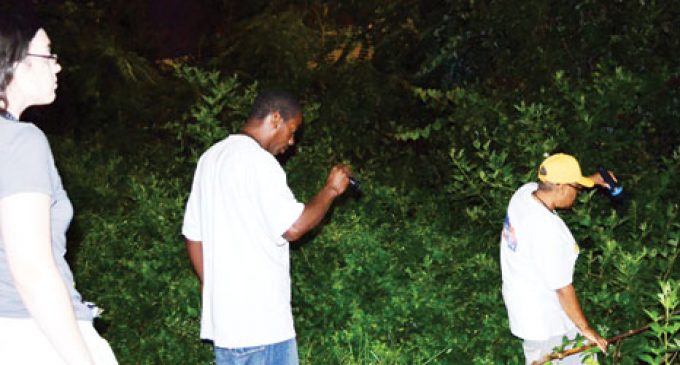Volunteers scour city in search of the homeless

When Winston-Salem resident George Grundy volunteered with the Point in Time (PIT) count in January, the experience of being homeless was still fresh in his mind.
Grundy, a former Marine who served in Afghanistan, spent six months living in his car until he was able to secure VA benefits to help offset his living costs. The 36 year-old laughs dryly when asked about the experience.
“Try living in your closet,” he said. “It was an experience.”
When he first participated in the PIT count – which is conducted twice a year to assess the city’s progress in addressing its chronically homeless population – Grundy was considered an expert, having only recently moved into his apartment. By the time the Flint, Mich. Native returned for the count last month, he had enrolled in school at Forsyth Technical Community College and had landed a job at Goodwill. Though his situation has changed for the better, Grundy said he’ll never forget what it felt like when he wasn’t so fortunate.
“Being on the count, it was humbling because I know I was just in that situation, just in that circumstance,” Grundy said. “I had just stepped out of that world so it was something that was dear to my heart, and that’s why I’m here now.”
Grundy was one of more than 40 volunteers who took to the streets to seek out the community’s unsheltered homeless population during the July 31 Point in Time count. Volunteers were broken into small teams and deployed in two shifts – from 9 p.m. to 12 a.m. and from 1 a.m. to 4 a.m. – to canvas the community in search of members of the local homeless population who chose not to seek the protection of area homeless shelters. Volunteers survey the homeless people they encounter, noting the location and number of individuals they find, and offer each person they encounter a bag filled with toiletries and nonperishable foods. Though the count requires volunteers to work into the wee hours of the morning, combing the woods, the streets and anywhere else an unsheltered person might be found, being a part of the effort is always rewarding, PIT Lead Organizer Teri Hairston said.
“The people that we engage are very happy for the relief that we bring and the fact that we come bearing things that will be helpful for them while they’re unsheltered,” she remarked.
City native Natasha Taylor said she was excited to be volunteering on the project for the first time. The mother of two added that she hoped her presence would be of help to the people she interacted with during the count.
“I have a heart for people,” Taylor said. “I enjoy helping people and seeing that they can make a better way for themselves.”
John Gladman, the assistant director of Social Services for the Salvation Army and a member of the Ten Year Plan’s Outreach Committee, said leaders were hoping for low numbers last week, following an encouraging finding earlier this year that the city has reduced its chronically homeless population – which is defined as people with disabilities who have been homeless for over a year or anyone who has been homeless three times within a two year period – by 58 percent since the Ten Year Plan began in 2007. Part of the success has been brought by a new approach to the issue that makes housing individuals its primary priority and offering other services secondary, Gladman said.
“Our chronic numbers have reduced drastically and we’re hoping not to find as many people,” he commented. “They have the opportunity to move rapidly into houses, they’re not in shelters as long and they have wraparound services, so that’s impacting the number of people that’s on the streets.”
Larry Calloway, the Veterans Supervisor for the the NC Department of Commerce’s Division of Workforce Solutions, was also in the number last week. Calloway, who was participating in his second PIT count, volunteered alongside Grundy in January. The Surry County resident said last week that he hoped the PIT count would be the start of another veteran’s success story.
“I hope tonight that we’ll find some veterans out there that when I stick my hand out, they’ll take my hand and actually pull (themselves) up,” he said. “I hope that they’ll realize that we care.”
Calloway, a Vietnam veteran and former Army medic, said his team visits local shelters weekly to seek out veterans and offer them support and connect them with other agencies that help veterans.
“They served us, we serve them,” he said. “If you’ve ever been in the military, you never stop serving. You still have that camaraderie.”
During the January PIT count, the United Way’s Ten Year Plan to End Chronic Homelessness joins service providers nationwide in conducting a coordinated PIT count to give a snapshot of trends in homeless populations nationwide. The July count is conducted by service providers in the county as a progress report of sorts for local providers, Gladman explained.
“We report all these numbers nationally to our federal government and it helps us shape and design policy,” he said. “…When we do the Point in Time counts, we’re trying to get a snapshot of how many homeless people are on the streets.”
Knowledge is power when it comes to helping this elusive group, Gladman told the volunteers.
“We cannot do it without the data – we cannot legislate what we do not see,” he told the volunteers. “We cannot do that without nights like this and dedicated people such as yourselves.”
Hairston has participated in the counts since the national effort began in 2007. Like Grundy, Hairston, a program assistant for the Ten Year Plan, has a personal connection to the issue.
“I am formerly homeless,” she revealed. “In October 1999, I fled my home because I’m a domestic violence survivor, with my two children. They were nine and 11, and we went and stayed in the battered women’s shelter.”
Hairston, a former police officer, said her own experiences with homelessness give her an advantage over the average volunteer when she reaches out to the chronically homeless.
“I don’t have an outsider’s perspective of the issue,” she said. “I know exactly what it is to be hungry. I know what it is to be uncertain about what I’ll eat and where I’ll sleep. I know exactly what it feels like to be a member of an emergency shelter system.”
Volunteers amassed a preliminary count of 50 unsheltered people, Hairston said. PIT leaders are still analyzing the data collected to identify any duplications that may exist in the count, but Andrea Kurtz, senior director of Housing Strategies for the United Way, said the preliminary numbers are on par with what PIT leaders had anticipated.
“For summer, that’s not going to be an unexpected number,” said Kurtz, a longtime advocate of eradicating chronic homelessness. “In the summer, people choose to camp out rather than going to shelters, so we would typically expect a higher number (than in January).”
Kurtz said the group hopes to release the official results of the count by the end of the month.











